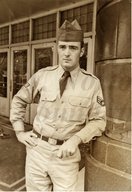
|

|
|
|
|
William was born in Newark, New Jersey, as one of three children of Martin J. Quinn and Margaret Mitchell Quinn. He was raised in an Italian-Irish neighborhood in Cork Lane, Pennsylvania, in the northeastern portion of that state. "My grandparents came and got me when I was two weeks old and took me to Pennsylvania," he recalls. "My dad and my mother moved back to Pennsylvania and that's where I was raised. His father, "a really good guy," as he calls him, worked in the rail yard of Lehigh Valley Railroad as a fireman and engineer. William says his father was adopted when he was three, and was a "family relative" to his parents. "His dad came from Ireland, the best I could ever find out, in the early 1900s," William recalls. "He couldn't take care of two boys so he got rid of both of them and my grandmother and grandfather Quinn raised them." William's grandfather worked as a conductor aboard a Lehigh Valley Railroad train that made daily runs to New York City. "I got to go to New York every other day all through the summer," he recalls. His father lost his job on the railroad, but began delivering milk. William arose at "2:30 or 3:00 o'clock" on Saturday mornings to help. By age 12 he was making a dollar a day by driving a truck on a family friend's bakery route. For recreation, William enjoyed ice-skating on frozen ponds. He also played football, basketball, and semi-pro baseball on a team sponsored by "one of the cafes or bars there in the area." He recalls earning fifty cents to two dollars, depending on the quality of his team's play. William graduated from high school in 1949, joined the U.S. Air Force in January of 1951, and took basic training at Lackland Air Force Base in San Antonio. He was then sent to aircraft and engine mechanic school at Sheppard Field in Wichita Falls, just as the military needed qualified personnel in many fields, because of the Korean War. "They needed aircraft mechanics so bad that they accelerated our basic training and sent us on to Sheppard and included the mechanic school with the training," he recalls. At Barksdale Air Force Base in Bossier City, he was assigned to work on the flight line in a post-flight crew, maintaining the aircraft of a squadron of B-29s. In 1953, by then a corporal and assistant crew chief, he went to Tinker Air Force Base in Oklahoma City for four months to install atomic bomb racks in B-29s. After that type of airplane was put out of service in 1953, he began working as a crew chief on B-47s. William left the air force after his initial tour of duty, but could not find a job in Pennsylvania, and soon re-enlisted. He returned to Barksdale, where his skills were badly needed, he recalls, because so many personnel were leaving the service. On February 4, 1955 he married Elsie Halford, a medical technician. They would have four daughters and five grandchildren. In 1958 he transferred to the 6th Bomb Wing at Walker Air Force Base in Roswell, New Mexico, and began working with the KC-135. Often, his crew went on alert--a seven-day period in which they were ready to fly at a moment's notice. In the 1960s he served three tours of duty in the Vietnam War, including being in control of the flight line of "60 to 80" airplanes at a time, including B-52s and KC-135s while based in U-Tapao, Thailand. "The B-52s launched three bombers every hour on the hour, 24 hours a day, seven days a week. It was a time that went really fast," he recalls. From December of 1970 until April of 1971, he worked without a day off. He returned from his last Vietnam conflict duty in May of 1971, and was stationed at Barksdale. During his career, he was in Strategic Air Command (SAC) for 26 years. William recalls the end of his career during "the Jimmy Carter years," a period he characterizes as one of low morale and difficulties with equipment. "I had ten B-52s on the end of the runway out there, just shells," he says. I had cannibalized them down to where there were just eight engines and a radio, just to get parts to fly with. And that was a culmination of the Vietnam War." When he retired in 1977 as a chief master sergeant he was maintenance superintendent for all 45 B-52s and KC-135s on the base. William worked as plant manager at an industry manufacturing Styrofoam cups, retiring 18 years later in 1997. |


